You are here
Deficits are Back on the Rise
Key takeaways from CBO’s updated outlook
The Congressional Budget Office (CBO) projects that the federal budget deficit will increase as a share of gross domestic product (GDP) for the first year since 2009. With the 2016 fiscal year nearly over, CBO’s new report confirms that the outlook for the federal budget has worsened since last year, with deficits rising by 35 percent from $438 billion in 2015 to $590 billion in 2016.
The 2016 deficit stems from a structural mismatch between revenues and spending: entitlement spending and interest costs are growing much faster than revenues. Between 2015 and 2016, CBO projects that revenues will grow by $26 billion, while spending will grow by $178 billion. Mandatory programs and interest costs represent the vast majority — 93 percent — of the spending increase.
CBO projects that:
- The budget deficit will reach $590 billion this year, growing as a share of GDP for the first time since 2009 and increasing by $152 billion since 2015.
- Over the next 10 years, debt will continue to climb significantly, reaching 86 percent of GDP in 2026 — more than double the 50-year historic average of 39 percent.
- Over the next 10 years, net interest costs will significantly increase, totaling $4.8 trillion.
In its most recent 30-year projections, released in July, CBO reported that our federal debt is on an unprecedented and unsustainable path, and could climb to 141 percent of GDP by 2046. In its new report, CBO warns that increasing long-term debt could significantly damage the economy if policymakers fail to address our nation’s fiscal imbalances:
“Such high and rising debt would have serious consequences, both for the economy and for the federal budget. Federal spending on interest payments would increase substantially as a result of increases in interest rates, such as those projected to occur over the next few years. Moreover, because federal borrowing reduces national saving over time, the nation’s capital stock ultimately would be smaller, and productivity and income would be lower than would be the case if the debt was smaller. In addition, lawmakers would have less flexibility than otherwise to respond to unexpected challenges, such as significant economic downturns or financial crises. Finally, the likelihood of a fiscal crisis in the United States would increase.”
The federal deficit will reach $1 trillion in 8 years
CBO projects that deficits will begin to rise again, after a period in which they declined following the financial crisis. The 2016 budget deficit will total $590 billion — $152 billion higher than 2015. By 2026, deficits will reach $1.2 trillion, resulting in a cumulative 10-year deficit of $8.6 trillion.
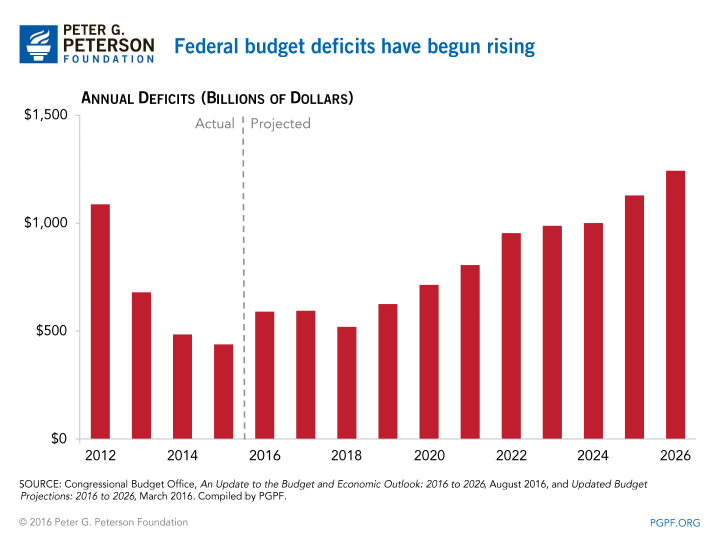
The increasing deficits are the result of the structural mismatch between how much the federal government spends and the amount of revenue it collects. Over the next 10 years, CBO estimates that revenues will stay stable at around 18.3 percent of GDP. Spending, however, is expected to rise over the same period, increasing from 21.1 percent of GDP in 2016 to 23.1 percent in 2026. CBO projects over the next ten years that federal spending will total $50.2 trillion, while federal revenues will total only $41.7 trillion. This gap will continue to widen significantly over the long term.
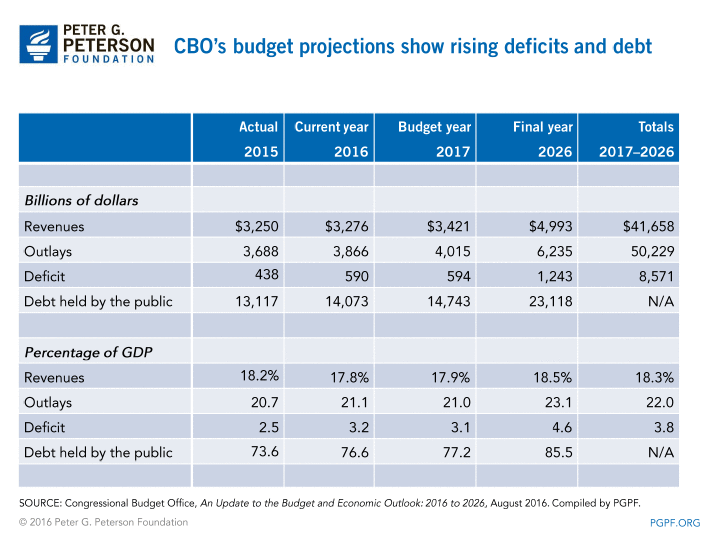
Federal debt levels are historically high, and growing
CBO projects that federal debt will climb to 86 percent of GDP in 2026, more than double the 50-year historical average of 39 percent. Since 1790, there have only been 7 years in which the debt-to-GDP ratio has exceeded 75 percent, and those were during and just after World War II. Beginning in 1947, debt began to fall sharply as a share of GDP, as the economy boomed and some debt was paid down. Today, the budget outlook is much more concerning because the projections show ongoing, significant increases in deficits and debt, due to growing entitlement and interest spending, combined with inadequate revenues.
Interest costs are projected to climb from growing debt and rising interest rates
As debt continues to accumulate and interest rates increase, net interest costs are projected to nearly triple over the decade, increasing from $248 billion in 2016 to $712 billion in 2026. Over 10 years, interest costs will total $4.8 trillion.
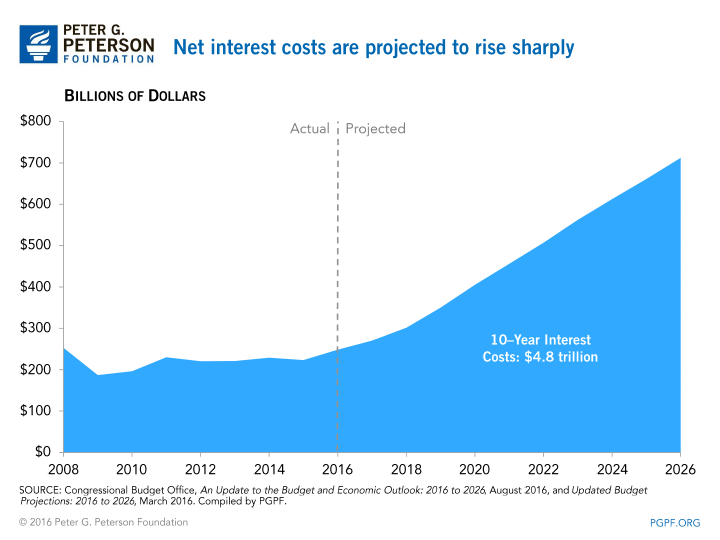
Mandatory spending is projected to increase significantly
Over the next ten years, mandatory spending (excluding net interest) is expected to increase by 68 percent, rising from $2.4 trillion in 2016 to $4.1 trillion in 2026. Social Security and the federal government’s major healthcare programs account for 90 percent of this increase in spending over the next 10 years.
- Major health programs: CBO projects that net spending for the major health programs will climb 78 percent, rising from $1.0 trillion in 2016 to $1.8 trillion in 2026. That increase reflects growth in three major programs: Medicare, Medicaid, and the exchange subsidies.1
- Medicare: As the baby boom generation continues to turn 65 and costs per beneficiary increase, net spending for Medicare will rise from $592 billion in 2016 to nearly $1.1 trillion in 2026.
- Medicaid: Medicaid spending is expected to rise from $365 billion in 2016 to $621 billion in 2026.
- Exchange subsidies: Spending on subsidies to help people purchase health insurance on the exchanges created by the Affordable Care Act is projected to increase from $43 billion in 2016 to $103 billion in 2026.
- Social Security: Spending on Social Security, currently the largest single federal program, will grow by 77 percent, rising from $910 billion in 2016 to $1.6 trillion in 2026, driven primarily by the retirement of the large Baby Boom generation.
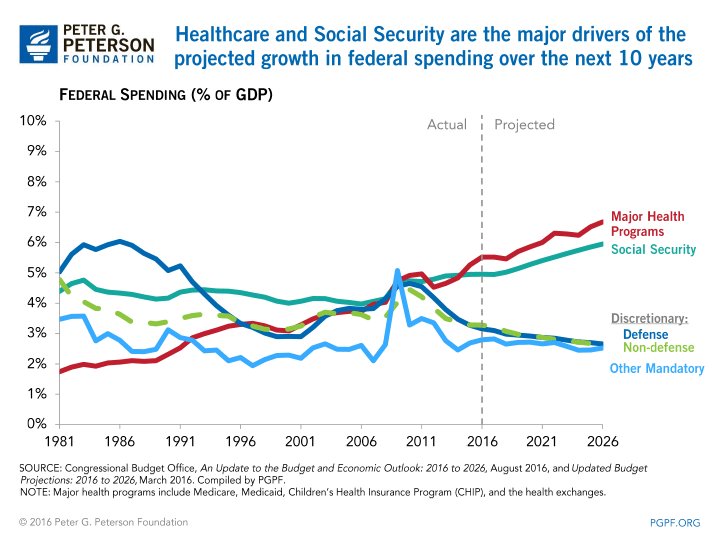
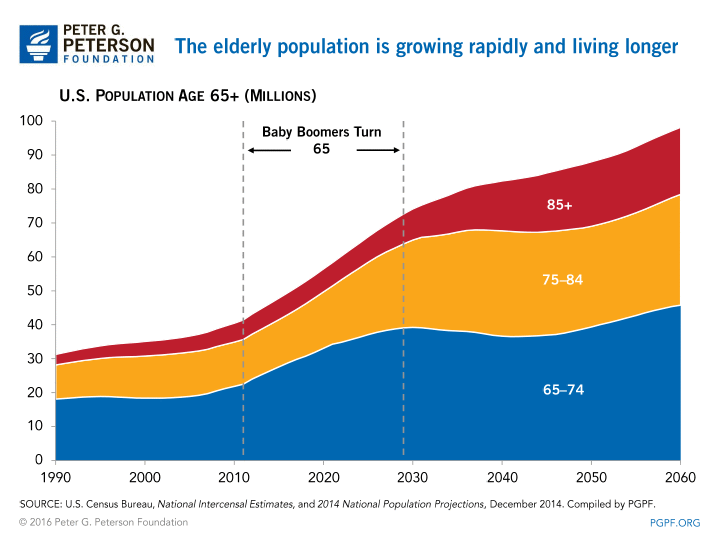
As spending on mandatory programs and interest costs rise, federal spending on discretionary programs will decrease from 6.4 percent of GDP in 2016 to 5.3 percent of GDP in 2026. This level of discretionary spending would be lower than it has been in any year recorded in its history, and 27 percent below its 20-year historical average. Discretionary spending funds a wide range of programs including R&D, education, infrastructure, national defense, and a host of other programs.
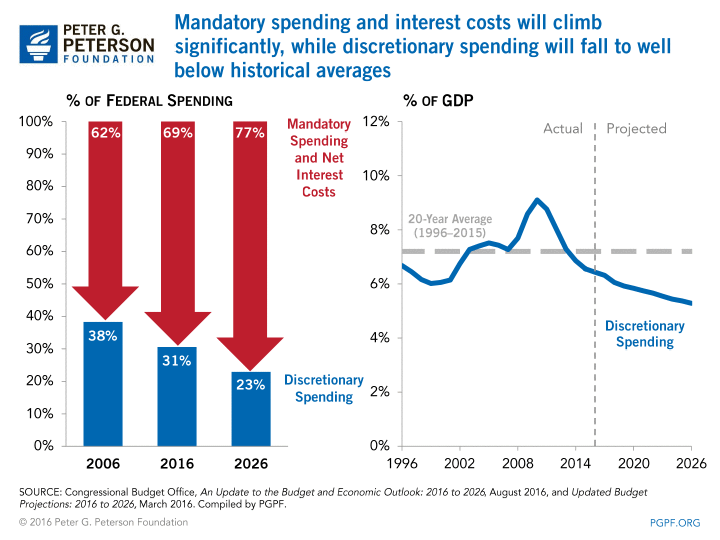
The time for policymakers to act is now
CBO’s report warns that the unsustainable trajectory of our long-term debt threatens to damage our economy. As the baby boom generation retires, the debt grows, and interest compounds, our debt and deficits will reach unprecedented levels. This growing debt reduces our ability to invest in the future, gives us less flexibility to respond to unexpected future challenges, and increases the chance of a fiscal crisis.
The fiscal challenges facing the United States are serious. In its most recent long-term budget report, CBO estimates that within 30 years debt held by the public could climb to 141 percent of GDP under current law — more than 3 times the 50-year historical average and well above the highest levels ever recorded in our history.
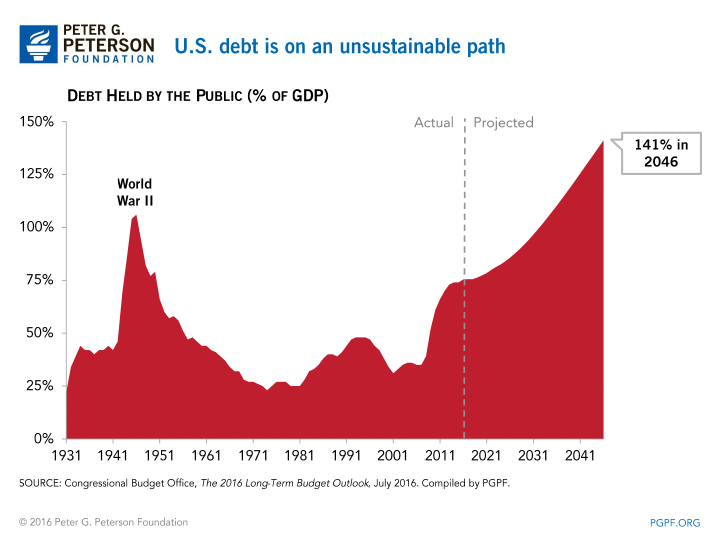
In recent years, many have said that the fragile nature of the recovery meant that it was not the right time to take fiscal action. However, the economy has improved considerably since the depths of the recession in 2009. The unemployment rate has declined from 10 percent in October 2009 to 4.9 percent in July 2016. According to CBO projections, the unemployment rate will remain at levels similar to the current rate.
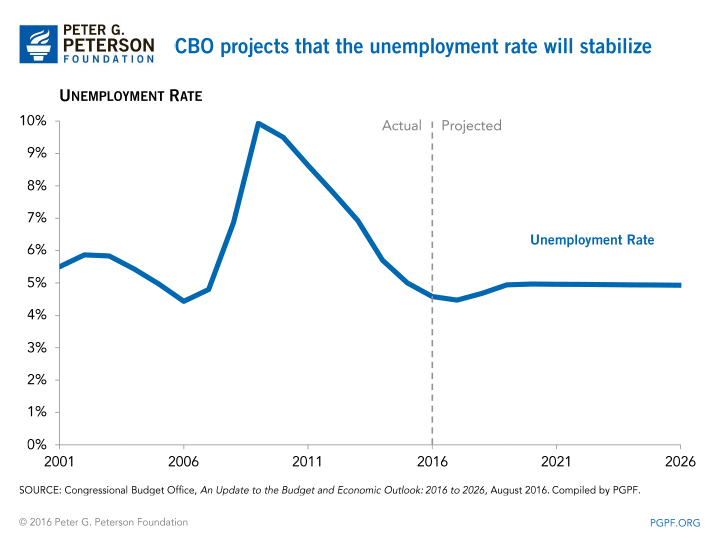
With a troubling fiscal outlook and continued economic recovery, we have the opportunity to make sensible reforms to spending and tax policies that will put our long-term fiscal trajectory on a sustainable path. The next president will face tough choices as debt continues to accumulate and interest costs crowd out spending on other programs such as education, infrastructure, and R&D.
As the election season continues, our fiscal situation demands attention — because it’s our economic future that’s at stake. The 2016 campaign is an important opportunity for voters and candidates to engage in conversation about America’s fiscal and economic future. To join this conversation, visit our website and ask the presidential candidates for a plan that addresses our national debt and secures our economic future.
Read the Statement from the Peterson Foundation on CBO’s Budget and Economic Outlook.
1 The Children’s Health Insurance Program is also included in major health programs, but spending on the program decreases from $14 billion in 2016 to $6 billion in 2026. (Back to citation)
